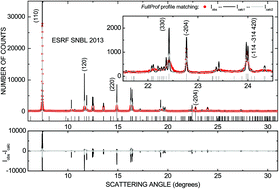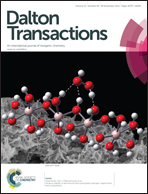The crystal structure of paramagnetic copper(ii) oxalate (CuC2O4): formation and thermal decomposition of randomly stacked anisotropic nano-sized crystallites
Abstract
Synthetic copper(II) oxalate, CuC2O4, was obtained in a precipitation reaction between a copper(II) solution and an aqueous solution of oxalic acid. The product was identified from its conventional X-ray powder patterns which match that of the copper mineral Moolooite reported to have the composition CuC2O4·0.44H2O. Time resolved in situ investigations of the thermal decomposition of copper(II) oxalate using synchrotron X-ray powder diffraction showed that in air the compound converts to Cu2O at 215 °C and oxidizes to CuO at 345 °C. Thermo gravimetric analysis performed in an inert Ar-gas reveals that the material contains no crystal water and reduces to pure Cu at 295 °C. Magnetic susceptibility measurements in the temperature range from 2 K to 300 K show intriguing paramagnetic behaviour with no sign of magnetic order down to 2 K. A crystal structure investigation is made based on powder diffraction data using one neutron diffraction pattern obtained at 5 K (λ = 1.5949(1) Å) combined with one conventional and two synchrotron X-ray diffraction patterns obtained at ambient temperature using λ = 1.54056, 1.0981 and λ = 0.50483(1) Å, respectively. Based on the X-ray synchrotron data the resulting crystal structure is described in the monoclinic space group P21/c (#14) in the P121/n1 setting with unit cell parameters a = 5.9598(1) Å, b = 5.6089(1) Å, c = 5.1138 (1) Å, β = 115.320(1)°. The composition is CuC2O4 with atomic coordinates determined by FullProf refinement of the neutron diffraction data. The crystal structure consists of a random stacking of CuC2O4 micro-crystallites where half the Cu-atoms are placed at (2a) and the other half at (2b) positions with the corresponding oxalate molecules centred around the corresponding (2b) and (2a) site positions, respectively. The diffraction patterns obtained for both kinds of radiation show considerable broadening of several Bragg peaks caused by highly anisotropic microstructural size and strain effects. In contrast to the water reported to be present in Moolooite, neither thermogravimetric nor the in situ thermal decomposition investigations and crystal structure analysis of the neutron diffraction data revealed any trace of water. An appendix contains details about the profile parameters for the diffractometers used at the European Synchrotron Radiation Facility and the Institute Max von Laue–Paul Langevin.


 Please wait while we load your content...
Please wait while we load your content...